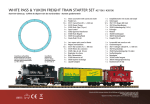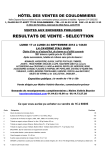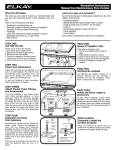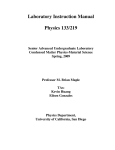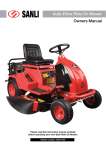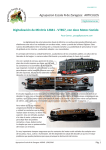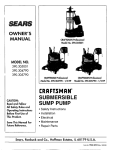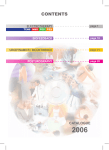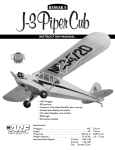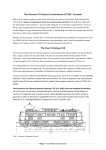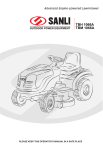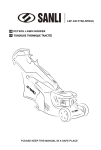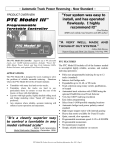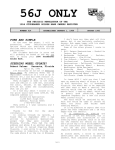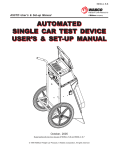Download The Keystone Modeler, No. 92, Spring 2015
Transcript
No. 92 Spring 2015 Inside: • Rivarossi U25C Review • 80F81A Tender for BLI H10S • Scratchbuilt FI Flat Car • Vandalia N6 Cabin Car in N NUMBER 92 Published Quarterly by The PENNSYLVANIA RAILROAD TECHNICAL and HISTORICAL SOCIETY A non-profit organization OFFICERS President Vice President Corporate Secretary Treasurer General Counsel Publisher Editor Membership Coordinator Membership Expediter Public Relations Manager Station & Archives Chairman Director of Wholesale Distribution Inventory Coordinator Donations Administrator Historian Webmaster Bruce F. Smith Edward Swain Ralph M. Weischedel Richard McCarty James G. Trope Frederick V. Shaefer Chuck Blardone Andrew J. Hart Brady McGuire Edward Swain Rich Ader Fred Freitas Donald E. Harper Jr. James E. Trunzo Christopher T. Baer Steve Agostini BOARD OF DIRECTORS Term Expires 2015 Term Expires 2016 Jack Consoli Bruce F. Smith Edward Swain Ralph M. Weischedel Marino (Joe) Acri Term Expires 2017 Frank Napoleon Dave Scott THE KEYSTONE MODELER STAFF EDITOR Jim Hunter [email protected] ASSOCIATE EDITOR Jack Consoli [email protected] NEWSWIRE EDITOR Steve Hoxie [email protected] EDITOR EMERITUS Al Buchan [email protected] CHAIRMAN MODELING COMMITTEE Elden Gatwood [email protected] ART DIRECTOR Tim Garner [email protected] Send comments and corrections to the Editor at: [email protected] MEMBERSHIP INFORMATION PRRT&HS, PO Box 54, Bryn Mawr, PA 19010-0054 CONTENTS SPRING 2015 FROM THE CAB Jim Hunter, Editor ............................................................................................................... 3 TKM NEWSWIRE By Steve Hoxie ..................................................................................................................... 4 IN MEMORIAM – STEVE AGOSTINI By Bruce F. Smith ................................................................................................................ 5 PRODUCT REVIEW – RIVAROSSI PRR GENERAL ELECTRIC U25C IN HO SCALE By Tim Garner ..................................................................................................................... 6 SCRATCHBUILDING A PRR CLASS FI GUN AND CABLE FLATCAR By David J. Vinci ................................................................................................................ 15 MEMBERSHIP INFORMATION MODIFYING THE 80F81A TENDER FOR THE BLI H10 S PRRT&HS, P.O. Box 54, Bryn Mawr, PA 19010-0054 By Chuck Cover .................................................................................................................. 21 MODELING A VANDALIA WOOD CABIN CAR IN N SCALE By Claus Schlund .............................................................................................................. 35 FRONT COVER, CLOCKWISE FROM TOP Rivarossi General Electric U25C (PRR Class GF-25a) in HO-scale. (Tim Garner) HO-scale scratchbuilt FI gun and cable flat in service. (David J. Vinci) Finished 80F81A tender modification to the stock Broadway Limited Imports H10s 2-8-0 steam locomotive. (Chuck Cover) Completed N-scale kitbash of a Minitrix caboose into a Vandalia N6 cabin car. (Claus Schlund) The Keystone Modeler This publication of the PRRT&HS is for the purpose of disseminating PRR modeling information. The copyright is owned by the Pennsylvania Railroad Technical and Historical Society – all rights reserved. It may be reproduced for personal use only. Not for sale other than by the PRRT&HS. Manuscripts and photographs submitted for publication are welcome. Materials submitted are considered to be gratis and no reimbursement will be made to the author(s) or the photographer(s) or his/her representative(s). The Society reserves the right to reject, for any reason, any material submitted for publication. Please contact the editor for information and guidelines for submission. Photo files 800x600 pixels or larger in JPG format are preferred. Statements and opinions made are those of the authors and do not necessarily represent those of the Society. The Keystone Modeler on CD-ROM Disc 1 Disc 2 Disc 3 Disc 4 Disc 5 Disc 6 Disc 7 Disc 8 August 2003 to July 2004 August 2004 to July 2005 August 2005 to July 2006 August 2006 to July 2007 August 2007 to July 2008 August 2008 to Autumn 2009 Winter 2010 to Autumn 2010 Spring 2011 to Winter 2012 TKM Nos. 1 – 12 TKM Nos. 13 – 24 TKM Nos. 25 – 36 TKM Nos. 37 – 48 TKM Nos. 49 – 60 TKM Nos. 61 – 71 TKM Nos. 72 – 75 TKM Nos. 76 – 79 Each disc is $15.00. There is also a disc containing all issues from 1 to 48 for $60. If you are a resident of Pennsylvania, please include PA sales tax. Send a check or money order in US dollars payable to PRRT&HS to: Jim Hunter 4306 North Victoria Way Harrisburg, PA 17112-8641 PRRT&HS MONTHLY E-NEWS [email protected]?Subject=subscribe To subscribe to The Keystone Modeler, click on the link below and send: mailto:[email protected]?Subject-subscribe To unsubscribe, click on the link below and send: mailto:[email protected]?Subject-unsubscribe The Keystone Modeler 2 No. 92 Spring 2015 The Pennsylvania Railroad Technical & Historical Society The purpose of the Pennsylvania Railroad Technical & Historical Society is to bring together persons interested in the history and modeling of the Pennsylvania Railroad, its subsidiaries and its acquired companies. Our goals are to promote the preservation and recording of all information regarding the organization, operation, facilities, and equipment of the PRR. The Society’s quarterly illustrated journal, The Keystone, has been published continuously since 1968. Each issue of 64 or more pages contains illustrated original authoritative articles about locomotives, cars, other equipment, facilities, and operating practices of the PRR. The Society also publishes its own thoroughly researched books and other materials concerning PRR history. The Keystone Modeler is also a quarterly special 30-plus page online publication of the Society. The Society meets annually, usually during a weekend in early May, providing an opportunity for its members to get together and learn more about the PRR. Local chapters around the country also provide members and guests with regular meetings that feature PRR related programs. Information about our Society may be found on our website – www.prrths.com. To join the Society, send $35.00 to: PRRT&HS PO Box 54 Bryn Mawr, PA 19010-0054 All memberships are for a calendar year, back issues of The Keystone for the current year are sent upon joining. Overseas membership has added postage fees. As a result of immigration, there are many different languages being spoken in the U.S. today, but English is our only common language. Because of that, we should want to use it clearly in communicating with one another. Some strange usages have crept into our speech in the past ten or fifteen years. People will say they received an “invite,” instead of an “invitation,” or they are getting a bathroom “install,” instead of an “installation,” or that the form on the computer has been “populated” instead of filled in. A nation or city is populated; not a form! Our hobby has also had some curious or (as my high school English teacher would say) lazy usages creeping in. A model is sometimes called a “build,” instead of describing what we do with the model, or the people responsible for a model are called the “creatives,” instead of the creators or producers, or competing products are called “comparators,” instead of competitors. By the way, prototype freight cars have built dates, not build dates. That’s why the abbreviation on the car side is BLT. Some new words and terms are useful, for example, “laptop,” “cell phone,” or “Digital Command Control” (DCC). But introducing a new word or the novel use of an old word just to sound cool, or hip, or in-the-know, often does not seem necessary or useful. Yes, of course languages change over time, and I know there are cultural, historical, and sociological explanations for the use of jargon, but words which exclude or obfuscate do not seem to me to have a place in our hobby. So, as Editor, I will replace verb/nouns such as “build” or strange nouns like “creatives” with older, clearer expressions. In the printed media (that word, incidentally, is a plural; a single one of those is a “medium”), there have been two recent articles of interest to Pennsy fans. The April issue of Model Railroader includes an article about Ed Swain’s Middle Division-inspired layout, and the April issue of Railroad Model Craftsman has an article by Gary Butts describing how he detailed an old Roundhouse kit to produce a Long Island G5s. In TKM this spring, we have a review of the Rivarossi U25C by Tim Garner, David Vinci’s scratch-built FI flat car, Chuck Cover’s tender kit-bash for his H10s, and Claus Schlund’s N scale Vandalia cabin car. Enjoy! PRRT&HS Interchange Selected Society Merchandise of Interest to Modelers PRR EQUIPMENT DRAWINGS ON MICROFILM Copies of PRR equipment drawings are available from the Society’s microfilm collection. To order drawings, you must know the drawing number and title. Ordering information and lists of arrangement drawings are available on the Society’s website. Go to www.prrths.com, select National Society, and then The Interchange. If you require a printed copy of this information, please send your address and a check for $2.00 made out to PRRT&HS to: Richard C. Price 779 Irvin Hill Road McVeytown, PA 17051 THE KEYSTONE CD 5 The Keystone CD No. 5, The Glory Days, covering 1998 to 2002, is now for sale at the price of $75 for members. New Jersey residents add $5.25 sales tax. Order CDs from: Al Buchan 785 Cornwallis Drive Mt. Laurel, NJ 08054-3209 THE KEYSTONE DVD 1 The Keystone DVD No. 1 covering 35 years of The Keystone from 1968 to 2002 is available. The navigation of this product is being upgraded as are some of the administrative notes and text. The improved edition will be ready for ordering soon. Those few who have already purchased the DVD will be able to trade it in for a new one when it’s available. The price of this DVD is $375. This DVD requires a computer with a DVD drive. It is NOT a video disk that can be played on a DVD player for viewing on your TV. Jim Hunter, Editor The Keystone Modeler 3 No. 92 Spring 2015 With Steve Hoxie PRR Product News GHB has informed us that the L1S is nearing production. Some last minute design issues are being addressed. Check the website for current information. BROADWAY LIMITED IMPORTS http://www.broadway-limited.com/ MICRO-TRAINS LINE http://www.micro-trainsline.com/ PRR 3D-7P2 Passenger Truck – N Scale As of this writing, BLI is listing April as the delivery date for the HO Sharks. Hopefully as you read this we will have them. Also, the HO L1S delivery date seems to be holding firm for July. The N M1A/B delivery is listed as August. Micro-Trains is producing this six-wheel truck, less coupler, based on the PRR class manufactured by Commonwealth. 36” wheels are included. This issue seems to have a tender emphasis, so let me add a little bit. With the advent of the L1S, BLI will be producing another tender which can be used with more than one engine class. Here are the possibilities: WALTHERS http://www.walthers.com/ PRR 2E-P5 (GSC 41-NP-11) Passenger Truck – HO Scale From the I1SA: 90F82 which can be used with the H10S (90F81) and a pre-World War II K4S (90F70). From the K4S: 110P75A which can be used with the I1SA (110F82A) and with the L1s (110P75A). Note that the L1S at the Pennsylvania Railroad Museum has this tender. From the L1S: 90F75 which can be used with the H10S (90F81A) and with the K4S (90P75) (Walthers) EASTERN SEABOARD MODELS http://www.esmc.com Walthers has in stock this truck used on their lightweight Pullman cars. Also available in silver. ESM now has a YouTube channel featuring their products: https://www.youtube.com/user/EasternSeaboardModel?featur e=creators_cornierhttp%3A//s.ytimg.com/yt/img/creators_corner/YouTube/yout ube_24x24.png&utm_source=ESM+News&utm_campaign=04 08d1dd16ESM_News&utm_medium=email&utm_term=0_bd8a87920b0408d1dd16-6568510 PRR 2D-P5 Express Truck – HO Scale GHB INTERNATIONAL http://www.ghbintl.com/ PRR L1S Steam Engine – N Scale (Walthers) PRR L1S pilot model. (GHB Photo) The Keystone Modeler 4 No. 92 Spring 2015 Walthers has this truck available with black, Tuscan, or olive green side frames. It is used with their R50B express cars and B60B baggage cars. Use with P70 coaches would require only conversion of the journals to roller bearings. PRR 2A-F5 “Caboose” Truck – HO Scale PRR 3D-P1 Six Wheel “RPO” Truck – HO Scale (Walthers) These are the trucks Walthers uses on their N6B cabin car models. PRR used the same trucks on N5B, N5C, N6B, and NDA cabin cars. (Walthers) Upcoming Events May 29-30 Collinsville, Connecticut New England/Northeast RPM Meet http://www.neprototypemeet.com/Welcome.html This is the version of the truck used on the Walthers BM70M RPO and has the step attached to the side. Note that on the Walthers web site, the photos are reversed and this truck is labeled the “Diner” version. They were correctly labeled in Walther’s flier announcing these trucks. August 7-8 Collinsville, Illinois (metro St. Louis, MO) St. Louis RPM Meet http://icg.home.mindspring.com/rpm/stlrpm.htm PRR 3D-P1 Six Wheel “Diner” Truck – HO Scale August 23-29 Portland, Oregon NMRA National Convention and National Train Show http://nmra2015.org/ Advance Planning September 25-26 Fredericksburg, Virginia Mid-Atlantic Railroad Prototype Modelers Meet http://www.marpm.org/ (Walthers) October 22-24 Lisle, Illinois Naperville RPM Conference http://www.railroadprototypemodelers.org/naper_meet.htm Here is the “Diner” version with no step. In Memoriam – Steve Agostini PRRT&HS Web Master Steve Agostini died suddenly after a brief illness late this winter. Steve, a former Pennsy, PC and Conrail employee, had been managing our website and discussion forum for many years. Just before he died, Steve had finished dealing with a malicious hacking attack on our website that took many days of hard work to identify and correct. Steve’s contributions to the PRRT&HS were many, and were often accomplished in the background, without the need or desire for recognition. Fortunately, at Steve’s insistence, we had safety systems in place which mean that our web presence has continued and will continue. Indeed, the PRRT&HS is currently formulating plans to build on the foundation that Steve created, to introduce an even better and more contemporary web presence. Thus, as president of the PRRT&HS, I want to take the opportunity to recognize Steve’s contributions and to say that he will both be missed and celebrated. Bruce F. Smith, President, PRRT&HS The Keystone Modeler 5 No. 92 Spring 2015 Product Review: The Rivarossi PRR General Electric U25C in HO-Scale By Tim Garner – photos by the author unless noted “Dis ain’t your daddy’s U25C!” With brass-quality road-specific detail and realistic rotating roller bearing axle ends, this model could not be farther from this manufacturer’s last attempt at this distinctive prototype. In late 2014, Rivarossi introduced an HO-scale version of the General Electric U25C. This model of the C-C version of GE’s first solo entry into the mainline locomotive market features all new tooling and ESU LokSound DCC. Overall, Rivarossi has done an exceptional job with this model including rotating roller bearing journals on the right side. PRR was also familiar with GE in the diesel realm. Fairbanks-Morse Erie-Built units were assembled at GE’s Erie plant and had GE electrical gear. GE produced a line of small industrial switchers beginning in 1940 that included the famous 44-tonners PRR purchased to eliminate A5S 0-4-0 steam shifters. From 1940 to 1952, GE was part of a consortium with Alco (Alco-GE) to design, produce, and market diesel locomotives. Alco locomotives were equipped with GE traction motors and generators. Raymond Patten, an industrial designer from GE, designed the bodies that would become the PA and FA Alco cab unit diesels. HISTORY OF THE U25C ON THE PRR GE has a long and interesting history in railroad motive power. Along with Ingersoll Rand, GE produced the first commercially successful diesel locomotive in 1928 – a boxcab design that saw service on Manhattan Island terminals after steam locomotives were outlawed. GE was often involved in the design and production of mainline electric locomotives in competition with Westinghouse. Once the joint marketing agreement between GE and Alco ended in 1953, GE decided to develop its own mainline diesel electric locomotives. Working with Cooper-Bessemer on a new prime mover, GE introduced a series of demonstrators starting with an A-B-B-A cab unit set in 1954. By 1959, GE rolled out two 2500 hp road switchers with FDL-16 V-16 engines. In the horsepower race, the GE offering would beat EMD’s 2250 hp GP30 and Alco’s 2400 hp RS-27. In 1960, U25B demonstrators were produced and sent on demonstration tours. GE was no stranger to the PRR either. The company provided the electrical gear for the O1 electric locomotive. They built 20 P5A boxcabs, 5 P5A modifieds, and provided electrical gear for several Altoona-built units. They provided electrical gear for one L6. GE built the first 16 GG1 locomotives and provided electrical gear for 51 Altoona-built copies. They built the E2B experimental electrics, the sixty-six E44 units from 1960, and even had provided the electrical gear in the secondhand FF2 units from the Great Northern. The Keystone Modeler 6 No. 92 Spring 2015 Class engine #6500 in Walbridge, Ohio on March 18, 1967. (William D. Volkmer collection) U25C #6503 leads #6512 and #6515 facing west at Altoona on May 4, 1966. The silver-framed windshield is prominent. (William D. Volkmer) GF-25a (U25C) #6504 leads an EF-36 (EMD SD45) with a coal train through Wilkinsburg, Pa. on February 21, 1969. Although this is technically Penn Central, the GE haulers were often paired with the big EMD’s on mineral trains near the end of the PRR. (Ken Douglas, William D. Volkmer collection) The Keystone Modeler 7 No. 92 Spring 2015 Here are GF-25a #6517, 6509, and 6510 on a TrucTrain in Wilmerding, Pa., east of Pittsburgh on May 21, 1966. Because of their low-speed lugging ability, they were more often found on coal and ore trains. (William D. Volkmer) A U25B demonstrator set made several trips on the PRR in February 1962. They impressed management and led to an order for seven units purchased at Uncle Sam’s expense to compensate for the impact of the Kinzua Dam project in Northwestern Pennsylvania. Four more orders followed. hooked. All PRR’s freight diesels purchased from then until the Penn Central merger had six powered axles. As part of an order for sixty 6-axle units from EMD, Alco, and GE, GE got two orders of ten U25C locomotives. The first order was placed in November 1964 and delivered in April 1965. The second order came in August of that year with delivery in November and December. To increase tractive effort and fuel capacity, GE designed the U25C. They extended the U25B chassis by four feet, moved air reservoirs from under the frame into a longer body, and set it on two 3-axle double-equalized “tri-mount” trucks – a design developed in the early 1950’s and found on PRR’s GE-built E44 electrics. Fuel capacity increased from 2900 gallons to 3500. Maximum tractive effort grew by 29,053 lbs. to 96,375. The body details on the first order (#6500-6509) are now described as Phase III by railfans. The main spotting details are a screened opening behind the cab for the air reservoir compartment with a rectangular screened opening on the roof. The first part of the second order (#6510-6516) had screened doors over the reservoir compartment instead of the large screened panel (Phase IIIb). The last three units (#65176519) were actually rated at 2,800 hp thanks to a faster turbocharger speed and other improvements – precursors of the U28C which PRR also purchased. Engines 6500-6503, 6510, and 6511 would eventually be retrofitted with these improvements. The PRR gave the U25C class GF-25a. Between September 1963 and December 1965, GE produced 113 copies of the U25C. They sold 30 to Northern Pacific, 21 to Atlantic Coast Line, 10 to Louisville & Nashville, 10 to Oro Dam Project in California (the first buyer), 12 to the Chicago, Burlington & Quincy, 2 to the Lake Superior & Ishpeming, and 20 to the PRR. The U25C was produced from September 1963 to December 1965. In service, the U25C was assigned to the Enola engine shop for maintenance. Thanks to their heavy-duty electrical gear, they were most often seen hauling coal and iron ore. Many photos show one U25C paired with an EMD SD45. All passed into Penn Central service. Until 1965, all PRR’s six-axle road switchers had been used as helpers, hump pushers, and heavy switchers. Then Electro-Motive’s SD35 arrived. These were the first six-axle freight diesels assigned to mainline freight trains. PRR was The Keystone Modeler 8 No. 92 Spring 2015 The engineman’s side of the Rivarossi model. Notice the see-through grilles for the radiator and air reservoir compartments. MODEL DETAIL The dummy receptacles PRR placed on the front and rear handrails to hold the loose end of an MU cable are missing. These are rarely modeled, but found on virtually all secondgeneration PRR power. Model railroaders who are getting a little long in the tooth will remember the U25C imported by AHM from Rivarossi in Italy beginning in 1966. The detail was good for its time, but the drive was not as robust as in Athearn diesels available at the time. The new Rivarossi offering, produced in China and distributed by Hornby America, is as good as any soundequipped plastic diesel model available today. Rivarossi’s first production run includes numbers from PRR’s second order. They include simulated screen door openings for the air reservoir behind the cab. Through some clever use of gray plastic and screen, they’ve created the illusion of two complete air reservoirs when actually there are two ends on the top and two rectangles on the sides. The radiator screens at the rear of the unit are also see-through. The PRR model is produced in what railfans describe as the Phase IIIb body. Most of the U25C’s manufactured fit this mold. Rivarossi worked directly with GE to accurately model the details including road-specific differences. For instance, the PRR model features a clean nose with no headlight. (With unwanted nose lights on most hood units by Athearn, AHM, and others, discriminating PRR modelers once had to become proficient with hobby knives and model putty just to properly place the nose keystone.) There is a signal control box on the walkway behind the cab on the left side, the correct horn, the correct horn and bell placement, and additional details for the extended-range dynamic brakes the PRR purchased. It also has a shorter ladder to the roof than the other roads. Rivarossi has done a fantastic job with the two biggest spotting features of the U25C – the windshield and the trucks. The nose-width one-piece windshield with a silver frame looks perfect and includes windshield wipers. Subsequent GE U-boats had two piece windshields. The tri-mount trucks with the heavy drop equalizers look especially powerful. There is a simulated speed recorder cable coming from the front journal on the engineer’s side and cables coming from all the journals on the fireman’s side. These were an early version of wheel slip control. The rest of the simulated roller bearing journals on the right side actually spin as the engine moves while appearing completely in scale. Neat! Rivarossi has also included sand lines. The pilot details include see-through steps and footboards, air hoses, brake hoses, cut levers, and MU receptacles. . Rivarossi has captured PRR-specific details such as the train-control box behind the cab, the hump in the catwalk to the rear of the unit, and the placement of the horn and bell. The Keystone Modeler 9 No. 92 Spring 2015 Other PRR-specific details include the lack of a nose light and a ladder on the left side of the rear hood. Unfortunately Rivarossi (and every other PRR diesel maker) has left off the dummy MU receptacle on the end railings found on virtually every second-generation PRR hood unit. OPERATION, PERFORMANCE, AND SOUND Another departure from the typical plastic model is the use of painted etched stainless steel for the side and end handrails and stanchions. They are flat and not the rounded piping of the prototype. Even so, they look in scale and the stiffness means they are likely to maintain the proper shape (unless dropped). The end railings also include real metal chain over the drop steps. All wheels meet the NMRA RP25 profiles. All wheels are driven and have electrical pick-up. The engine has a can motor with flywheels inside a die-cast metal frame. Drive shafts connect the engine to gear towers on each truck. The drive is very quiet. The top speed of the loco is high, but this can be adjusted with CV settings or taking it easy on the throttle. The weight of the locomotive at over 20 ounces gives it significant pulling power. Painting and lettering is acceptable. The dark green locomotive enamel is a little too green – a mistake most manufacturers make. The Dulux gold on the numbers and railings is too yellow as well. The keystones and radio decals are accurately done and placed as are the lighted number boards. Most of the smaller lettering on the hood and frame found on the prototype is missing on the model. It may be possible to add some of it with diesel data sets from Microscale. During part of their PRR operating lives, these locomotives had ACI identification (color barcodes) on their flanks as well. The Keystone Modeler The Rivarossi engine has plastic Kadee-compatible couplers on each end that are a bit oversize. Unfortunately, the shank on these couplers is especially thick so dropping in No. 58 scale couplers won’t work without modifications to the coupler pocket. The model comes equipped with either standard DC or a DCC LokSound Select dual mode decoder and speaker from 10 No. 92 Spring 2015 Rivarossi has captured early anti wheel-slip technology on the left side axle ends. Sand lines are included as it the unique PRR radio decal. The rotating bearing ends on the right side of the model are the stand-out feature on this Rivarossi offering. The Keystone Modeler 11 No. 92 Spring 2015 ESU. I purchased the latter. The decoder plugs into a 21-pin socket in the printed circuit board. The board also includes an 8-pin socket. The sound quality is very good. light should always be on when the loco is operating. Out of the box, the engine has a very slow start then the engine rpm increases before the speed increases. It is set up for manual notching using function buttons independent of the throttle. If you operate more than one of these locomotives together in a consist, those features are fine. If you consist the U25C with another manufacturer’s locomotive (as was common on the prototype), you may need to try and disable some of the momentum and manual notching effects to even up the speeds. The sounds also include horn, bell, sanding valves, and coupler. You can set these off by function buttons or set them to automatically occur when the engine shuts down. The LokSound decoder can be customized in a number of ways. A full user manual is available at http://www.esu.eu/en/start/. For a PRR modeler, Rivarossi’s U25C is the best model yet of a distinctive prototype. It was the first of a long line of high horsepower six-axle diesels that would propel General Electric to the top of the world diesel locomotive market. CONCLUSION SOURCES AND RECOMMENDED READING • Paul K. Withers, Pennsylvania Railroad Diesel Locomotive Pictorial, Vol. 11, Alco and GE Road Switchers, Withers Publishing, ©2008. • Ken Douglas and Peter Weiglin, Pennsy Diesels 1924-1968, Hundman Publishing, ©2002. • Alvin Staufer, Pennsy Power, Alvin F. Staufer, ©1962. • Alvin Staufer, Pennsy Power II, Alvin F. Staufer, ©1968. • “GE U25B”, Wikipedia.com, 03-25-2015. • “GEU25C”, Wikipedia.com, 03-25-2015. LED’s light up the headlights and number boards. Since the U25C was built after 1956, by federal regulation, the head Note the see-through screens over the air tanks behind the cab. The Keystone Modeler 12 No. 92 Spring 2015 ▲ Note the see-through stair treads and pilot, the hood ladder, and the appropriate grab irons. The lack of a few fine lettering details is the only knock on the exterior detailing of this model.◄ The illusion of full gray air reservoirs is carried off perfectly. ▼ The left side of the engine. The Keystone Modeler 13 No. 92 Spring 2015 ▲The chassis and body. The speaker is to the right. The gray piece to the left shows through the screen in the side of the hood as an air reservoir. ▼ The model is paired with an Athearn SD45 and an empty coal train on my Willsburgh Division layout. Note the lighted numberboards. The Keystone Modeler 14 No. 92 Spring 2015 Scratchbuilding a PRR Class FI Gun and Cable Flat Car By David J. Vinci One of the recent projects of the PRRPro Yahoo Group was the Class F22 and F23 Gun and Cable Flat Cars (built in 1912). As I am a fan of the early equipment and model the 1920s, I wondered what did the railroad use before the F22? The answer turned out to be the Class FI, built in 1897. The railroad only built five of this class in 1897, but the 1919 ORER shows four of them still in service, (#435497-435500) and the 1925 ORER shows none. In Figure 1 is a collection of drawings of the Pennsylvania Railroad’s gun flats cited in the table above that serves as a visual comparison of the various classes of these cars. There were evidently not very many of these classes of high capacity cars except for the class F22. Pennsylvania Railroad Gun and Cable Flat Cars Class Date Length Adopted Capacity (Lbs.) 1919 ORER Lines East FD 1887 39’ 2” 120,000 4 FE 1889 40’ 5” 100,000 4 FF 1892 33’ 100,000 2 FG 1892 55’ 7” 150,000 1925 ORER Lines East 1925 ORER Lines West 1 1 1 2 FI 1897 36’ 4” 100,000 4 F22 1912 30’ 150,000 6 F23 1912 30’ 150,000 Totals: 1919 ORER Lines West 10 113 10 6 20 10 123 11 Each class is unique and interesting in its own way and worthy of modeling. I decided if I could get enough information, I would see if I can make presentable models of some of them. I was able to get a copy of a drawing of the Class FI, so that will be the subject of this article. From that drawing I made a modeling drawing which I printed in full size for HO scale so I could transfer the dimensions directly from the drawing to the work pieces (see Figure 2). There was one part of the original drawing that is shown in Figure 3 as it better explains the car’s construction. The horizontal beam to which the truss rods are attached is wood. The main structural parts of the frame are made of two C-channels, bolted together. There is a piece of lumber bolted to the fabricated frame to permit the deck boards to be nailed (or bolted) to the frame. I chose to make the frame parts of solid plastic, but you could follow the prototype and use C-channel. I took a few other liberties with the model as you’ll see. Just chalk it up to modeler’s license. Figure 4 shows the details of the parts of the HO scale car I built. Figure 5 shows the construction of the end blocks of the car and is pretty self-explanatory. It’s really just a bunch of plastic shapes laminated together with liquid cement. I used 220-grit sandpaper to refine the shape of the ends after the cuts were made. I made these first and then sort of built up the car between them. The Keystone Modeler 15 No. 92 Spring 2015 The Keystone Modeler 16 No. 92 Spring 2015 The Keystone Modeler 17 No. 92 Spring 2015 To make the center section of the car, I started with a sheet of 0.040” thick plastic 9’ wide and 34’ long. I laminated a sheet of 0.020” thick 0.060” V-groove siding that was the same size to it. This gave me the thickness of the deck boards I was looking for. Then I drew on the bottom side the center line and the position of the queen posts and the truck bolsters. 56 screw for attaching the trucks. These were then glued in place to the center sills as shown in Figure 6. The next step is to finish the underbody as shown in Figure 7. The truck bolsters were made from pieces of 0.125” square strip as were the queen post support beams. See Figure 3 and Figure 4, section A-A, for the details of the queen post bolsters. Instead of making a custom part to secure the truss rods to the bolsters, I used some 6” queen post castings. You could use 3” queen posts or make the custom parts as shown in Figure 3. The train line I made using 0.035” plastic rod and the brake levers were made with scraps of 0.020” thick sheet plastic. The truss rods were made using 0.015” wire anchored in holes through the center sill. An alternative would be to use nylon fishing line and then you could thread on some turnbuckles. You can add as much or as little detail to the underbody as you like because some of it you won’t see unless the car is turned over. I did add the nut, bolt, washer castings to the ends of the truss rod support bolsters as well as on the side sills. You could even add them at the ends of the grab irons as some folks do. The center sills are made using a strip of 0.100” x 0.125” to which a strip of 0.020” x 0.100” is cemented to the 0.100” side. This yields a center sill with a scale 12” height as compared with the 0.100” x 0.100” side sills which scale out to about a 9” height. These center and side sills were cemented to the floor and then the end blocks cemented in place. When attaching the ends to the center section of the car body, make sure the bottom center of the end and the taller center sill are matched in height. This will make the end protrude above the decking on top by 3 scale inches or so. The center beams were trimmed to clear the Kadee coupler boxes which will pass thru the cut-out we made in the end blocks earlier. The 2’ x 2’ squares of 0.040” thick plastic were drilled and tapped for a 2- The Keystone Modeler 18 No. 92 Spring 2015 Figure 8 The ends of the car have a plate through which the coupler passes. I made this from 0.005” thick plastic. I cemented the Kadee coupler boxes in place with just a tiny amount of cement so I could remove them later if that ever becomes necessary. I like to put these in place with screws, but on this car there wasn’t room (thickness) to do that. I did have to put a 0.015” shim between the coupler box and the floor so the coupler height was correct. This is dependent upon the trucks and wheel sets, etc, so test fitting and comparing things with the coupler gauge is critical to good operation. Now the Tichy #8034 Truss Rod end bolts can be added to the ends around the coupler, 2 above the coupler pocket and one on each side of it as shown in Figures 4 and Figure 11. Drill #76 holes for the A-Line corner strap steps and use ACC to hold them in The Keystone Modeler place. Next I turned the car right side up and finished the detailing as shown in Figure 8. The coupler access plate was made from 0.005” thick plastic sheet to the dimensions shown in Figure 4. On the prototype, this plate is bolted down to permit access to the coupler mechanism, so I used Grandt Line #5066 1¼” nut, bolt, washer castings not rivets. Yes, they are pretty small, but they drop right in a hole made with a #78 drill. In Figure 8 you can see the small lip formed where the end block is slightly taller than the deck boards. The grab irons on the end blocks have a small relief made in the edge of the end so there is “finger room” between the grab and the end. A small detail, but you can see it, so I included it. There is a brake wheel on each end of the car as shown in Figures 2, 4 and 8. 19 No. 92 Spring 2015 Trucks for this car presented a bit of a problem, but I like the compromise I settled on. The original car had 5’ wheel base arch-bar trucks with 30” wheels. I settled on using Tahoe Model Works part #TMW 111 five foot wheelbase trucks with 33” wheels. You may be able to find some appropriate 30” wheel sets if you wish. And now you should be ready to go to the paint shop. I painted the car body and truck side frames with a mix of Poly S Special Oxide Red and Reefer Orange. The deck was painted with Reefer grey and then weathered with some dilute Rail Brown followed by a light wash with an alcohol and India ink mixture. The lettering is from some Westerfield XL decal sets. Figure 9 is a sort of “Builders photo” of the finished car. Notice how you can see the brake rigging and the brake cylinder hanging down under the car along with the truss rods. Like most flat car models, this one has little space for added weight. The trucks I chose are plastic side frames and metal wheels and axles so they don’t contribute much weight. Using white glue, I affixed as much No. 7½ lead shot to the under frame between the center and side sills as I could, but the result was a car that only weighs 1.4 oz. NMRA recommendation for a 36 foot car should be around 3½ ounces. Well, the car tracks well and so far it has not been a problem, but I think a heavy load will become the order of the day. The Keystone Modeler Figures 10 and 11 are photos of the car in service on my 1920s layout. Figure 11 shows the end detail including the relief for the grab irons and the positioning of the truss rod end bolts and the air hoses. Have fun with your project. 20 No. 92 Spring 2015 Modeling the 80F81A Tender for the BLI H10S By Chuck Cover – Photos by the author unless noted H10s #7688 on my layout in Shamokin. H10S #7555 on my layout in Mt. Carmel. INTRODUCTION trucks, and the 2E-F13 (note 2), cast steel trucks replaced the earlier trucks on most of these tenders in the mid 40’s (note 3). Many of the other details on the model are post-war, per Tim’s article, so the pre-war trucks will have to be changed out for those modeling the more modern era. The PRR modeling community has been patiently waiting for the release of the BLI H10S, and when it finally arrived, I was very impressed with the model. Tim Garner’s great product review in TKM Volume 90 confirmed that BLI got most everything right with their new release. Since I model the 1950s Shamokin Branch, I knew that the model, out of the box, would not meet my needs. I have been on a steep learning curve, studying the H10S (note 1) and discovering where they were used on the PRR’s vast system. I have come across a good number of photos of H10S locomotives on the Branch and in Northumberland. I knew from the start that the “Lines West” 80P81 tender with the Crawford hood did not show up on the Branch, but I was a little disappointed that BLI used the original 2E-T1 trucks on their model. The 2E-T2, crown-like The Keystone Modeler Steve Hoxie’s definitive article on the tenders used with the H10S in TKM Volume 91 is a perfect lead-in to my modeling article. There were several H10S stokered locomotives (note 4, 5, and 6) with modified 80P81A tenders on the branch in the 1950’s. I was able to find photos of #7555 and #7688, which can be seen here (figures 1 and 2) and in Bert Pennypacker’s Pennsy Steam Years 3 (Morning Sun Books, ©2001). Several other photos of these two locomotives can be found on John Dziobko’s godfatherrails.com web site. 21 No. 92 Spring 2015 Figure 1. H10S #7555 at “LUKE” just west of Mt. Carmel in 1957. (Bill Ellis from Pennsy Steam Years 3, Morning Sun Books, used with permission) Figure 2. H10s #7688 the Shamokin engine terminal in 1956. (Arthur Angstadt from Pennsy Steam Years 3, Morning Sun Books, used with permission) The Keystone Modeler 22 No. 92 Spring 2015 I decided to model these two locomotives for this project, both of which had the 80P81A Altoona tender conversions. There are slight external differences between the Altoona and Columbus conversions, but both consisted of removing the Crawford hoods from the 80P81 tenders and adding new coal bunker/side sheet extensions. In conversations with Bob Hess and Steve Hoxie comparing the two conversions, the Altoona conversion has more of a “stylish flair,” with curves at the transitions and rounded corners at the top of the side sheet extensions. The Columbus conversion is all “straight” angles. Although I will describe modeling the Altoona conversion, if you want to do a Columbus conversion to match your prototype of choice, the methods will be the same with the exceptions of the shape of the side sheet extensions and the rivet lines. serting a scalpel blade between the two pieces and gently prying the plastic body up. Work the wire harness and drawbar hook through the space at the front of the body and unplug the rear marker lights from the circuit board. The white wire is on the lateral-most slot on the 3-wire harness. Remove the two screws that hold the Crawford hood in place and set the hood aside (figure 3). There are two cast-on slope sheet angles on the top of the tender floor behind the slope sheet. Using a chisel blade, shave them off. DECONSTRUCTION OF THE BLI TENDER Using a chisel blade, pry off the water scoop from the bottom of the tender. Remove the top chord and the highest horizontal rivet line on each side of the tender with a sharp chisel blade starting at the top of the front curve of the top chord and ending at the second to the last set of three vertical rivets (figure 4). This is where the new coal bunker side sheet extensions will be added. Start by removing the tender body from the frame by in- Figure 3. Stock tender after removal of frame and Crawford hood. Figure 4. Tender after removal of top chord The Keystone Modeler 23 No. 92 Spring 2015 CONSTRUCTION OF THE BLI TENDER of the top chord so that the seam can be easily sanded and will become almost invisible. Let them sit overnight so that they are thoroughly dry. The next day, finish bending each side sheet extension inboard so that it fits onto the slope sheet angles. Glue the slope sheet and the inside of the side sheets using liquid styrene glue. Once everything is dry, the sharp angles of the side sheet extensions are sanded to round them off. Also, carefully file the side sheet extensions to create the slight curvatures seen in the photographs. To simulate the beading glue Plastruct .010” square rod over the scored line and down the sides of the side sheet extensions to join the original top chord using photographs as a guide (figure 10). I sized the arrangement drawing (figure 5) from Rob Shoenberg’s web site so that it was HO scale. Using the arrangement drawing, I determined the dimensions of the slope sheet and side sheets for the 80F81A tender. Those dimensions were transferred to sheets of .040” sheet styrene and cut out using the chisel blade (figures 6 and 7). Cut the vertical slope sheet which fits onto the top of the tender floor between the top chords and at the back of the opening created when the Crawford hood was removed. I eyeballed the angle of the slope sheet from photos. Temporarily fix it in place with a few drops of ACC until the side sheet extensions are in place. Cut the two side sheet extensions. Each side sheet extension should be scored on the outside of the sheet, 15 scale inches from the bottom (do not cut the score too deep). Slightly bend each side sheet extension inbound along the score line using a straight edge. The side sheet extensions will attach to the slope sheet to obtain the prototype shape. This final fitting will be done later. The coal bunker floor unit was made using .040” sheet styrene. The dimensions were calculated by measuring the inside of the coal bunker between the side sheets (figure 11). The front of the unit is a scale 2’-6” high. Once assembled, it can slide inside the side sheets and will come to rest against the slope sheet at the back of the bunker (figure 12). The detailed bunker door was cut off the Crawford hood with a razor saw and glued to the front of the bunker floor unit (figure 13). Once I had fitted the bottom unit into the bunker, I test fitted the tender body back onto the original frame. Unfortunately, the capacitor would not allow the body to snap back down on the frame. I removed the bunker floor unit and cut a slot out of the floor so that the capacitor would not be compressed. Once everything properly fit, I secured the bunker floor unit with liquid styrene cement. Attach the side sheet extensions to the top chord using liquid styrene glue. The side sheets are located, back to front, using the vertical rivet lines as landmarks. The back end of the extension should be located directly above the second set, from the back, of three vertical rivets. The front end should be located at the top of the curve of the top chord right behind the front most vertical rivet line (figures 8 and 9). Be sure both sides are situated properly, and are even with the outside Figure 5. PRR 80F81A/80P81A tender arrangement drawing. (Rob Schoenberg) The Keystone Modeler 24 No. 92 Spring 2015 Figure 6. Diagrams for cutting out the slope sheet, side sheet extensions, coal bunker. Figure 7. Slope sheet and side sheet extensions cut from .04” sheet styrene. Templates were first made out of construction paper to attain the correct size/shape. Figure 8. Photo of 80P81A tender for #7688. (Larry Hanlon) The Keystone Modeler 25 No. 92 Spring 2015 Figure 9. New side sheet extension attached to top chord of tender. Note: water scoop has not yet been removed and 2E-T1 trucks. Figure 10. ¾ view of new tender, slope sheet, side sheet extensions and bunker floor unit, note that the beading has been added to side sheet extension. On the deck of the tender, right behind the slope sheet, a sheet of .040” sheet styrene was cut a scale 9’-6” long and 21” high and glued in place. Braces were fabricated from 1’ x 3” strip styrene and a scrap ladder was secured to the rear of the slope sheet and tender deck (figure 14). to retain as many of the rivets as possible. Once everything was sanded, I gave the sides a quick, light coat of flat black primer. I find that one can see areas that may need more filling or sanding when the sides are a uniform color. Once you are satisfied with the sanding, Micro-Mark decal rivets were placed on the tender (figure 16), using photographs (figure 17) as a guide. Note that I added the patch near the bottom of #7688 (figure 18). The rivet lines are different for the Altoona and Columbus conversions. The tender sides need to be carefully sanded to hide the seam line where the side sheet extensions were attached to the top chord (figure 15). You want to hide the seam but attempt The Keystone Modeler 26 No. 92 Spring 2015 Figure 11. Fabrication of coal bunker floor unit base. Figure 13. Front of tender with doors taken off model’ Crawford hood and glued to bunker floor unit. Figure 12. Coal bunker floor unit slipped between side sheets. Figure 14. Rear view of tender with floor angle behind slope sheet, two vertical braces and ladder. tender (figure 20). The other change is that the electrical wipes on the H10S trucks are wider than on the I1SA trucks, which I found out once I received my parts order. My expectations were that all I had to do was purchase a set of BLI 90F81 tender truck side frames (2E-T2 trucks) and 33” wheels from the BLI I1SA parts list and slap them on the bottom of my newly converted tenders. No such luck. TRUCK MODIFICATIONS Converting the original 2E-T1 trucks on the lines west (LW) tender to the proper 2E-T2 trucks on #7688’s 80F81A tender (figure 19) became the most difficult part of this project. Unfortunately, the design of the tender truck bolsters and the trucks themselves, how they attach to each other, changed between the I1SA 90F81 tender and the H10S 80P81 The Keystone Modeler 27 No. 92 Spring 2015 Figure 15. Tender being sanded to hide joint line of new side sheet extension. Figure 16. Model with new rivet lines (Micro-Mark rivet decals). Figure 17. Photo of 80P81A tender for 7688, note rivet lines and patch. (Larry Hanlon) The Keystone Modeler 28 No. 92 Spring 2015 Figure 18. Model with new rivet lines, note patch (Micro-Mark rivet decals). Figure 19. Close up photo of 2E-T2 trucks on tender for #7688. (Owen Thorne) Figure 20. 2E-T1 truck from BLI H10S model on left, 2E-T2 truck from BLI I1SA model on right. Figure 21. Center area filed off of 2E-T2 truck (left) so that it will fit new bolsters. The Keystone Modeler 29 No. 92 Spring 2015 Figure 22. Underside of 2E-T2 truck, reinforced and filed to accept metal wipers of 2E-T1 truck (left), undersides of new 2E-T2 truck (middle) and 2E-T1 truck (right). I ended up doing a lot more work than I needed to do with the trucks. Since I did not want to wait for another parts order (I need to be more patient), I used the LW tender truck electrical wipes, which are wider than the I1sa tender wipes, so I did a lot more sanding to make them fit which weakened the side frames. I had to go back and reinforce the side frame with small pieces of styrene. Below, I have described exactly what I did for this project, but some of this work can be avoided if you order the proper wipes with the I1SA tender truck side frames and wheel sets. Take the 2E-T2 side frames (from the I1SA tender) and glue a piece of 6” x 8” strip styrene reinforcement inside the bottom of the truck frame. File a scale 3” off the top of each side frame (figure 21). This is where the truck attaches to the bolster. You need to sand this so the truck clears the round metal protrusion that is the new truck bolster on the H10S, enough so that there is a little play for good tracking. Enlarge the center hole in each truck to accommodate a length of 3/16” styrene tube. Figure 23. Jig to drill new holes for metal wipers. these reinforcements would interfere with the trucks, however, I have thoroughly tested the completed locomotives and tenders on my layout and they run great. Turn the truck side frame over and file both sides of the underside slot in the bottom of the frame so that the wipers from the H10s will fit into the frame (figure 22). The plastic bosses in the wipers of the original LW truck are also on opposite sides compared to the 2E-T2 side frames, so new holes need to be drilled. Use a piece of 0.04” sheet styrene to fit into the bottom of the original LW truck to use as a template to drill the new holes for the wipers (figure 23). Drill a hole in the center of the template that matches the center hole in the trucks and slide the 3/16” tube through it to properly position the template. Drill holes in the template for the wipers using the holes in the LW truck as a guide. Transfer the template to the new trucks, center it with the 3/16” tube and drill the new holes for the wipers. Still using the tubing to center the wipers, glue the wipers into the new truck side frame. Reinforce the truck side frames with various pieces of strip styrene and liquid styrene cement. I was worried when I had finished that The Keystone Modeler If you are smarter than I was and ordered the I1SA wipers, you can skip the work on the bottom of the new truck, described in the above paragraph, and simply enlarge the center hole in the I1SA wipers and install it on the truck side frame. Cut a scale 18” piece of 3/16” tubing, square the ends and slide it through the new truck side frame. Glue the tubing in place, leaving about scale 6” above the side frame which will then fit into the tender bolster. Install the 33” wheel sets. One truck should be insulated on the left, the other on the right. Ream out the center of the 3/16” tubing so that the truck bolt and spring slides through the tubing and attaches to the bolster. 30 No. 92 Spring 2015 Figure 24. Photo of #7688 showing location of front marker lights. (Owen Thorne) Figure 25. Model showing removal of pilot beam marker lights and addition of bull’s eye marker lights on smokebox. LOCOMOTIVE MODIFICATIONS this use the Detail Associates part. More detail could be added to each locomotive, such as adding the water supply lines from the tender. The 80P81A tenders were converted from the lines west version when the PRR modified the H10S to stokered versions. I studied several photographs of the modified #7555 and #7688 locomotives and made the following changes to the stock BLI H10S. On both locomotives the marker lights were moved from the pilot beam to the front of the smoke box (figure 24). To remove the marker lights one must take a chisel blade and slip it under the bottom of the marker light and pry upward. The marker light should pop off. The LEDs for the BLI marker lights are lit at all times and will still be in place inside the pilot beam. Black out the LED with black paint, both on the top and bottom of the pilot beam. Using Cary parts, glue the marker lights to the appropriate locations on the front of the smoke box (figure 25). The BLI bell needs to be rotated 180 degrees. Touch up the new details with a flat black paint. I used decals from Wilson Locomotive Works. The coal bunker was filled with scenery goop and shaped. After it had dried, it was painted black and scale coal was sprinkled over the wet paint. The coal load was set with rubbing alcohol followed by diluted glue. The two units were weathered using an air brush. Weathering the drivers requires a cradle set up in the spray booth so that the drivers are moving while being weathered. Photographs of finished models (figures 29, 30, and 31). This was a very interesting project. I enjoyed researching the prototype and working out how to model the locomotives and tenders so that they are more suited to the area and era that I model. I will probably want to have additional H10S on the layout. From Keyser’s chart (note 4), and by studying photographs, it is clear that the two locomotives had different stokers installed. Number 7555 had a Berkley stoker, and #7688 had a much more common HT stoker (figure 26). To represent these stokers I used Cal-Scale parts and installed them with 5-minute epoxy under the firemen’s side of the cab. Each detail part was too long to fit under the cab and part of the stoker had to be trimmed off for it to fit properly. Use .04” dia. brass wire to represent the steam exhaust line to the locomotive using photos to orient it (figure 27). THANKS I want to thank Steve Hoxie, Bob Hess, Larry Hanlon and Owen Thorne for their kind help and advice and for sharing their knowledge and photographs. Number 7555 had a signal box, located on the firemen’s side of the loco along the walkway (figure 28). To represent The Keystone Modeler 31 No. 92 Spring 2015 Figure 26. Photo of HT stoker on #7688. (Owen Thorne) Figure 27. Fireman’s side of #7688 with HT stoker and steam exhaust. Figure 28. Fireman’s side of #7555 showing Berkley stoker and signal box. REFERENCES Note 4 – PRR-FAX Files section, H10S Locomotive Assignment/H10S (stoker) – Roster -1-revised by Roger Keyser, updated by Bob Hess. Note 5 – The Keystone, Vol. 12, No. 2, p. 11 – close-up photo of standard stoker engine beneath the cab. Note 6 – The Keystone, Vol. 20, No. 3, p. 21 – Experience with PRR Locomotive Stokers, p. 42 photos of Berkley stoker. Note 1 – PRR-PRO Files section, H8, H9, and H10 information. H10s data pdf from Bob Johnson. Note 2 – The Keystone, Vol. 20 No. 1, p. 58 – photos of H10S tenders including two of the 80P81A (both Columbus conversions). Note 3 – PRR September 1956 Form 109L The Keystone Modeler 32 No. 92 Spring 2015 SUPPLIES Part 43.......................................... Truck electrical wipers (2) Evergreen Scales Models 9040 ...............................................040” sheet styrene 9020 ...............................................020” sheet styrene 8208 ..............................................2” x 8” strip styrene 8608 ..............................................6” x 8” strip styrene 8103 ..............................................1” x 3” strip styrene 266 .................................................3/16” styrene tube Cal-Scale 190-224 ....................................... HT stoker used on most H10S 190-254 ........................................ Berkley stoker used on 3 H10S Cary ML-159 ......................................... PRR modern marker lights DA-2305 ...................................... Signal Box (early type with 3 straps) Piping .......................................... brass wire ....................................................... Plastruct 90709 .............................................010” square rod Micro-Mark 84985 ............................................HO rivet decal set Decals Wilson’s Model Works Number boards and back of tender numbers made on computer Excel file Broadway Limited Imports I1SA 90F81 Tender Parts Part 42 ..........................................Tender truck side frames (2) Part 44 ..........................................33” diameter wheelsets (4) Coal load Made from scenery goop (vermiculite and Celluclay (50-50), mixed with house paint and Elmer’s glue (50-50) until the mixture is the consistency of oatmeal. Ladders ......................................scrap off freight car kits Figure 29. Finished model – weathered tender #7688 . The Keystone Modeler 33 No. 92 Spring 2015 Figures 30, 31. Finished model – weathered tender #7688. The Keystone Modeler 34 No. 92 Spring 2015 Modeling a Vandalia Wood Cabin Car in N Scale By Claus Schlund – Photos by the author unless noted Figure 1. PRR 982016 (likely ex-Vandalia 5316) trails an H25 on a coal drag. Once the Vandalia was merged into the larger PRR system proper, a series of Vandalia wood cabin cars built by American Car & Foundry (AC&F) became part of the PRR roster. While PRR historians and researchers are still somewhat uncertain on this, there is discussion that these cars might possibly have been classified by the PRR as the “mysterious” class N6 (no letter suffix). More research remains to be done on this topic before the definitive answer is known. carbody, cupola, and trucks from three disparate sources could make a very plausible model. BUILDING THE MODEL Start with a Minitrix caboose body (figure 5). Take everything apart, and file down the body bolsters from a thickness of 0.145” to 0.120” removing 0.025” (figure 6). This will allow the car to sit at the proper height over a pair of Bachmann oldtime passenger trucks. Use a set of Micro-Trains #1128 couplers in the existing draft gear box Inspecting a close-up and looking over the few details that can be discerned in the fuzzy prototype photo (figures 3 and 4) of this Vandalia cabin, I concluded a combination of . Figure 2. Being a predecessor line, the Vandalia had its own collection of rolling stock which fell distinctly outside the strict standardization imposed by the PRR. (Westerfield ACFdisk) The Keystone Modeler 35 No. 92 Spring 2015 ▲ Figure 3. PRR N6 #982016 in the second “no keystone” scheme coupled to a Lines West H10s. (Claus Schlund collection) ► Figure 4. A less than clear blow up of the cabin car helps show some details. Fill the smokejack hole on roof, if you have the factory smokejack, then glue the factory smokejack in place and trim flush when dry. My smokejack was missing, so I drilled the hole out to 1/16” diameter and glued in a piece of 1/16“diameter plastic rod instead. Sand all roof detail off of the roof until the roof surface is smooth. caboose roof, so lightly file or sand the cupola bottom in the right spots to improve this fit. In addition, extend the cupola opening a bit on the other end to align the end of the cupola with the edge of the window opening on the car side. Remove the factory end railings. Glue the mounting pins cut from the factory end railings into the mounting holes on the end platform and trim flush with end platform surface. Discard the crude factory end rails. We will not be using them. Remove the molded-on factory side railings. Assemble everything and it should look like the image above. Do a quick test of the running gear, correcting any problems and making sure couplers are at the proper height. The cupola needs to move closer to the end of the car than it was in the factory model, so close off some of the cupola opening in the roof by gluing two thicknesses of 0.080” styrene into the opening. Allow glue to thoroughly set and sand to match roof contour. Use a Micro-Trains wide caboose cupola to replace the factory cupola. The Micro-Trains cupola bottom surface is not an entirely exact match to the Minitrix Figure 5. Stock Minitrix caboose. The Keystone Modeler Figure 6. Stripped Minitrix body with Bachmann trucks. 36 No. 92 Spring 2015 Figure 7. Body with holes for Watts marker lights. Figure 8. With Watts marker light openings framed with styrene. Cut holes for the Watts marker lights. Do this by first making a round opening with a drill and then using a X-Acto #11 blade to carve a more-or-less rectangular opening (figure 7). per wire around the shaft of a 0.104” drill bit. Trim the resulting spiral to an appropriate length and slip it over the truck bolster pin shank to get a good fit between trucks and bolster pins. Add caboose underframe body supports made from 0.030” x 0.030” styrene stock (figure 9). Frame the Watts marker light openings with 0.010” x 0.010” styrene strips (figure 8). Having moved the cupola closer to the end, the factory roofwalk will no longer fit. One section will be too long and the other too short. Cut the toolong roofwalk to be a bit shorter and glue the removed section of roofwalk material onto the too-short piece of roofwalk to lengthen it. Sand off the molded-on grab iron detail from the cupola roof. File the round factory roofwalk mounting pins to have a narrow profile and add extra roofwalk supports made from 0.010” x 0.020” styrene evenly spaced at 1/8” intervals. Glue the roofwalk to the carbody roof. Make J-shaped side railings by bending 0.010” dia. phosphor-bronze wire around a 1/8”drill bit shaft. The wire will spring back somewhat after forming, so experiment until the result you get is a 90 degree curve. Install on the four corners of the cabin car body. Add end ladders made from Gold Metal Models #160-15 Freight Car and Industrial Ladders and end railings bent from 0.012” phosphor-bronze wire. The prototype car image is too fuzzy to make out the exact end rail configuration. All I could see was that the end ladder was at its standard location. I simply configured the end rails according to standard PRR practice of the time (figure 10). Now is also a good time to add roofwalk end supports bent from 0.010” diameter phosphor-bronze wire . Since I wanted the carbody to remain removable, all the end railing parts are spindly little things sticking straight up into the air (figure 11). Use caution since one careless move could wipe out an afternoon worth of work! Drill a 0.063” diameter hole to install a Micro-Trains caboose smokejack. Add the required window muntins using 0.020” x 0.020” styrene stock. Paint the carbody and underframe PRR Freight Car color (figure 12). I use a mix of equal parts Floquil Boxcar Red and Zinc Oxide Primer for this. The Bachmann trucks have a 0.147” diameter bolster hole, but the bolster pins have a 0.112” diameter shank, which means there is too much back-and-forth slop in the fit of the trucks. Fix this by wrapping a spiral of 0.015” diameter cop- Figure 9. Underbody with Bachmann truck mounting details. The Keystone Modeler Figure 10. End ladder and railing arrangement. 37 No. 92 Spring 2015 Figure 11. Chassis with end details installed. Figure 12. Completed body before lettering. CREDITS Once the paint is fully cured, apply a coat of Testors Glosscote. Apply decals lettering the car as PRR 982016. I had trouble finding a decal sheet that had the word “PENNSYLVANIA” with sufficiently close spacing. In the end, I went with Mount Vernon Car Shops’ decal sheet N PRR Wreck Derrick Decals. Northeast Decals “Standard Boxcar B&O-09” provided the digits. After the decals are fully set, seal with Testors Dullcote. Weather the car then glaze the windows. Add a 0.25 oz lead weight to the car interior. The car is ready for service (figure 13). I need to acknowledge the generous help of Rich Burg, Rick Tipton, Bob Johnson, and Gary Rauch without whom this project would not have been possible. If I have omitted anyone, please understand it is due to my own clumsiness! REFERENCES The Keystone, Vol. 43, No. 3, p. 38 has images of Pennsylvania #982016 and also Vandalia #5316 (likely the same car). Figure 13. The finished model. The Keystone Modeler 38 No. 92 Spring 2015






































